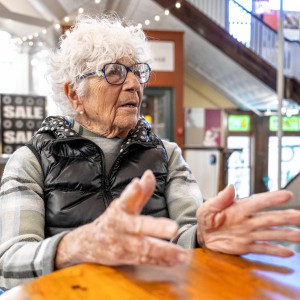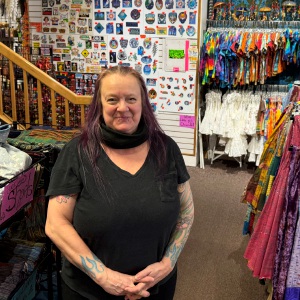Prosecutors say Carrillo case represents difference between addict and dealer
| Published: 06-15-2017 8:21 AM |
NORTHAMPTON — Prosecutors never alleged that New Hampshire resident Jesse Carrillo intended to kill fellow University of Massachusetts student Eric Sinacori with the heroin he supplied. They didn’t allege he was selling the drug for personal gain.
Instead, prosecutors say they charged Carrillo with involuntary manslaughter because he was providing a drug he knew carried a deadly risk.
“Any time someone makes the conscious decision to sell or distribute drugs — particularly an inherently dangerous drug like heroin — they are no longer just jeopardizing their own lives, they are jeopardizing the lives of anyone who may consume those drugs,” First Assistant Northwestern District Attorney Steven Gagne said in an interview.
A Hampshire Superior Court jury recently found Carrillo, 28, guilty of involuntary manslaughter and drug distribution. Sinacori, 20, of Whitehouse Station, New Jersey, was found dead by his father in his off-campus apartment on Oct. 4, 2013. Authorities concluded he had died of a heroin overdose.
Judge John Agostini sentenced Carrillo to 2½ years in the Hampshire County Jail and House of Correction. He must serve one year; the remaining year and a half will be stayed on the drug distribution charge if he complies with his probation. Carrillo’s attorney, J.W. Carney Jr., has appealed the conviction.
“I think what the Carrillo case represents is the distinction between a drug addiction and drug users on the one hand versus drug distributors on the other,” Gagne said. “Jesse Carrillo wasn’t prosecuted for being a drug addict or taking heroin. He wasn’t being prosecuted for importing heroin into Massachusetts for his own use. Where he crossed the line in our view was when he started giving it to others.”
Throughout the trial Carney argued Carrillo was not a drug dealer but rather a young man in the throes of his own addiction. In supplying Sinacori with the heroin, Carney argued Carrillo was one addict helping another.
This is the second time during District Attorney David Sullivan’s more than six-year tenure his office has brought manslaughter charges against someone in a fatal overdose.
Article continues after...
Yesterday's Most Read Articles
 ‘Delightful’ Northampton store shopping guide Jane Hertz, 88, seeking next gig
‘Delightful’ Northampton store shopping guide Jane Hertz, 88, seeking next gig
 ‘Whole campus’ approach: UMass working to help six students whose visas, status were revoked
‘Whole campus’ approach: UMass working to help six students whose visas, status were revoked
 Five UMass Amherst students have visas, student status revoked
Five UMass Amherst students have visas, student status revoked
 Amherst finance director to return to UMass
Amherst finance director to return to UMass
 ‘Hands Off’ protest: 5,000 people in half-dozen Hampshire County communities protest against Trump policies
‘Hands Off’ protest: 5,000 people in half-dozen Hampshire County communities protest against Trump policies
 Long-vacant former Faces spot in Northampton gets new tenant
Long-vacant former Faces spot in Northampton gets new tenant
In March, Eric Lagare, 31, of Athol, was sentenced to five years in jail for his involvement in the heroin overdose death of 22-year-old Jordan Tarbell, of Athol. Lagare pleaded guilty to involuntary manslaughter and three counts of distributing heroin, a count of possession with intent to distribute heroin and conspiracy to violate drug laws.
As part of the same case, Brian Welvaert, 34, of Athol, pleaded guilty to involuntary manslaughter, one count of distributing a class A drug, conspiracy to violate drug laws and misleading police. He was sentenced to six months in prison for distributing heroin, and two years probation on the involuntary manslaughter charge.
Gagne described the Carrillo and Lagare cases as “the exception rather than the norm” because the district attorney’s office’s “focus is first and foremost treatment over jail.”
“We’re not naive enough to think that if we prosecute the occasional drug dealer, Jesse Carrillo or Eric Lagare, that that is going to scare dealers straight and get a message out that it’s not worth it to deal drugs,” Gagne said. “The reality is that it’s going to keep happening but we do believe that where a case is provable, and where we can prove a crime has been committed and somebody has lost their life as a result that, prosecution is one part of our approach to this epidemic.”
By analogy, Gagne said if a drunken driver crosses over the center line and kills an oncoming motorist, why would prosecutors only charge that driver with operating under the influence, and not motor vehicle homicide?
“Whenever there is sufficient evidence to prove that a person’s conduct resulted in death, that person should be held responsible for the consequences of their actions,” Gagne wrote in an email.
“As much attention as Carrillo gets, that really is the anomaly. Day in and day out, the work that we are doing is on prevention, it’s on treatment and in those rare cases where incarceration is necessary, we do seek that,” Gagne said.
Incarceration could serve as punishment for some or as an opportunity for others to get the help that they need, Gagne said.
In 2009 under then Northwestern District Attorney Elizabeth D. Scheibel, a Northampton man was found guilty of a single count of manslaughter in connection with the 2008 heroin overdose death of UMass student Darby Fassett.
Following a bench trial, Justin P. Morin, 21, was sentenced to two years in jail. The district attorney’s office initially charged Morin with distributing a class A drug but later dropped the charge and replaced it with manslaughter.
At the time of Morin’s sentencing, Hampshire Superior Court Judge C. Brian McDonald said “in some cases the deterrent message must be broadcast no matter what deafness it falls on.”
In 1998, authorities brought manslaughter charges against four men in connection with three heroin overdose-related deaths in a Northampton rooming house. Prosecutors dropped charges against one defendant. Two other defendants received lengthy probation terms. The fourth defendant, who authorities said actually injected a friend with heroin, was ultimately sentenced by a judge to 11 months in jail.
For Northampton defense attorney Alan Rubin, of the Committee for Public Counsel Services, most criminal penalties, especially those regarding the most addictive drugs, haven’t proven to be much of a deterrent.
“I don’t think any criminal penalties are the way to go,” Rubin said. “I don’t say that I have any miracle cure but locking up people and punishing people doesn’t seem to play any role. In general, penalizing people doesn’t seem to do much good and seems to create a lot of other societal harm.”
In the last few years, the court system has been looking for less punishment and more treatment alternatives, Rubin said.
“As always, there is never enough funding for the long-term, intense treatment that seems to be the most successful in drug treatment,” he said. “The court system and some of the prosecutors are trying, but doing a good job requires much more funds than are available or will probably be available.”
Rubin said there has to be some level of accountability but doesn’t see any reason why there has to be such a “schism” between the justice and treatment systems.
“I don’t see why we couldn’t construct a system where treatment is the just result. If treatment leads to the person not doing wrong again, that is a win-win,” he said.
Art Way, of the national nonprofit Drug Policy Alliance, agrees with Rubin that more money is needed for treatment. Way serves as a senior director of criminal justice reform strategy as well as being the Colorado state director for the Alliance.
Prosecuting drug death cases only makes the problem worse, Way said.
“It drives the issue of drug dependency further underground. It makes it less likely that those who need help will look for help,” he said.
The only thing it achieves, according to Way, is the ability for law enforcement to “pat themselves on the back” and say they did something.
“Overall, it’s just a typical punitive reaction from law enforcement to try and deal with an issue that cannot really be dealt with in a punitive fashion.”
Way contends that the answer lies with law enforcement, treatment and prevention all working together to “aggressively educate” the public around drug dependency.
“We need to engage with the community and create treatment-on-demand facilities and increase our treatment infrastructure and increase our education around drug dependency,” Way said. “We don’t invest in that. We invest in incarceration and trying to send messages.”
Marisa Hebble, of the Massachusetts Community Justice Project, said people with addiction too often find themselves cycling through the criminal justice system. She said over the years the justice system has made strides in recognizing that addiction is a disease.
Hebble said the justice system has made a big shift, but there are limitations on how much change can be expected from the system without legislation. She said the justice system’s involvement should be seen as an opportunity for treatment and resources and it should happen at every stage of law enforcement, not just when an individual arrives in court or is incarcerated.
“With that said, the justice system was developed to hold people accountable for violating the law,” Hebble said. “These two truths are operating in parallel. My perspective is that they don’t always overlap. They overlap in a number of places but they don’t always.
“The justice system is not the treatment system and vice versa.”
Over the course of the Carrillo trial, the defense called an expert witness, Dr. Sarah Wakeman. Wakeman, an addiction medicine physician and the medical director of Mass General’s substance use disorder initiative, served on the Governor’s Opioid Task Force.
Talking to the Gazette two weeks after the trial, Wakeman talked about the opioid crisis, addiction and the role of public health.
“We shouldn’t be criminalizing a disease. We’ve spent many decades as a society trying to criminalize our way out of addiction and it hasn’t been successful,” she said. “From a public health standpoint these types of policies have very real negative outcomes.”
As a physician, Wakeman said she was worried about those impacts.
“Everywhere you go now, we hear people say how we are not going to arrest and incarcerate our way out of this crisis. I think that it is absolutely true but there is a bit of conflict there if our policies are still going to incarcerate people,” Wakeman said.
Like Way, Wakeman sees a need for more treatment options.
“Make it the easy choice. Make treatment available basically everywhere,” she said.
Wakeman said, given current realities, there is absolutely a role for the criminal justice system. But, she said, the fact that we need criminal justice to be part of the treatment is a failure of the public health system.
Reached after the trial, Carney said he was pleased to hear prosecutors are acknowledging that heroin addicts need treatment, and not incarceration. He said he was troubled that they “refuse to accept the reality of what being a heroin addict means.”
The fact that his client provided heroin to another addict, he said, simply means he was participating in that risky subculture.
“Experts tell us that heroin addicts usually try to obtain heroin for other heroin addicts so that they will have access to safe heroin and avoid the torture of withdrawal. It is hypocritical for prosecutors to treat heroin addicts as the equivalent of heroin drug dealers simply because they assist other heroin addicts in obtaining heroin,” Carney said.
“Jesse Carrillo never sold heroin either for a profit or to support his own drug habit. If another heroin addict had the funds to purchase heroin, Jesse was willing to obtain him for it at the same time he obtained it for himself. The goals were the same — to satisfy the unbelievable craving the body has for heroin and to avoid merciless torture of going through not having access to heroin. It is literally torture.”
During trial, Carney compared Carrillo’s actions to those of someone picking up a gallon of milk for their neighbor at the corner store or picking up a case of beer for a friend.
The prosecutor doesn’t buy the analogy.
“It was really apples and oranges in our view,” Gagne said. “Heroin is illegal and there is no circumstances under which a person can purchase it, sell it, distribute it.
“Just because you’re addicted to a substance, particularly heroin, doesn’t necessarily mean that you are predisposed or inclined to cross that line into dealing or distributing,” Gagne said. “Instead, rather than just feeding his own addiction, he chose to facilitate the addiction of others. He chose to not just supply himself but to also draw others into the vortex of his own addiction.”
Emily Cutts can be reached at ecutts@gazettenet.com.
]]>






 FBI conducts court-authorized investigation at Hockanum Road home in Hadley
FBI conducts court-authorized investigation at Hockanum Road home in Hadley  Northampton takes aim at renter-paid broker’s fees
Northampton takes aim at renter-paid broker’s fees Q&A with UMass President Marty Meehan
Q&A with UMass President Marty Meehan
